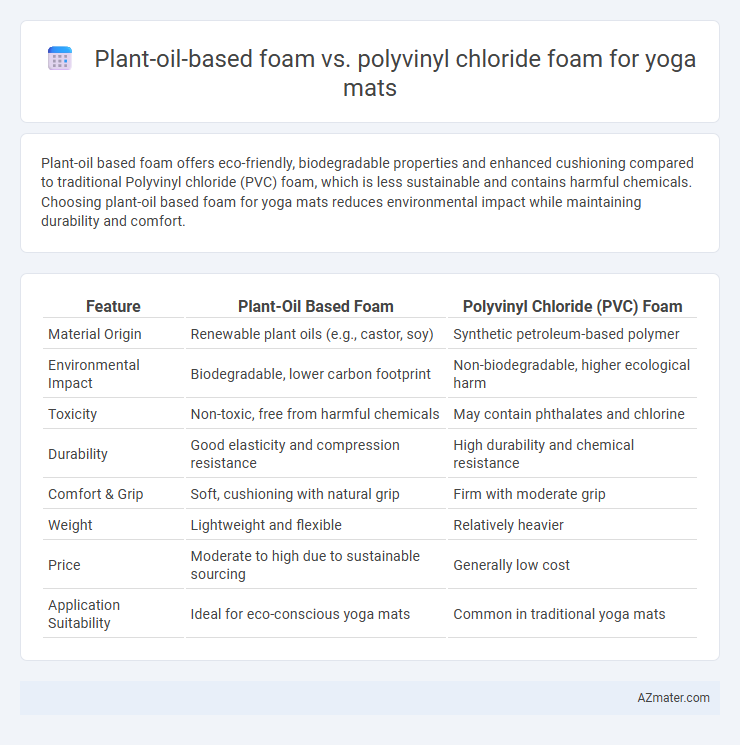Plant-oil based foam offers eco-friendly, biodegradable properties and enhanced cushioning compared to traditional Polyvinyl chloride (PVC) foam, which is less sustainable and contains harmful chemicals. Choosing plant-oil based foam for yoga mats reduces environmental impact while maintaining durability and comfort.
Table of Comparison
| Feature | Plant-Oil Based Foam | Polyvinyl Chloride (PVC) Foam |
|---|---|---|
| Material Origin | Renewable plant oils (e.g., castor, soy) | Synthetic petroleum-based polymer |
| Environmental Impact | Biodegradable, lower carbon footprint | Non-biodegradable, higher ecological harm |
| Toxicity | Non-toxic, free from harmful chemicals | May contain phthalates and chlorine |
| Durability | Good elasticity and compression resistance | High durability and chemical resistance |
| Comfort & Grip | Soft, cushioning with natural grip | Firm with moderate grip |
| Weight | Lightweight and flexible | Relatively heavier |
| Price | Moderate to high due to sustainable sourcing | Generally low cost |
| Application Suitability | Ideal for eco-conscious yoga mats | Common in traditional yoga mats |
Introduction to Yoga Mat Materials
Plant-oil based foam and polyvinyl chloride (PVC) foam represent two common materials used in yoga mats, each offering distinct environmental and performance characteristics. Plant-oil based foams, often derived from renewable resources like soybean or castor oil, provide a more eco-friendly alternative with biodegradability and lower toxic emissions compared to PVC foam, which is synthetic, durable, but less sustainable. The choice of material impacts factors such as cushioning, durability, chemical safety, and environmental footprint, influencing consumer preferences in yoga mat selection.
Overview of Plant-Oil Based Foam
Plant-oil based foam for yoga mats is derived from renewable resources such as castor, coconut, or soybean oils, offering a sustainable alternative to traditional polyvinyl chloride (PVC) foam. This bio-based foam provides excellent cushioning and durability while being biodegradable and free from harmful chemicals like phthalates and heavy metals commonly found in PVC. Enhanced breathability and moisture-wicking properties contribute to a non-toxic, eco-friendly yoga mat that supports both user health and environmental sustainability.
Overview of Polyvinyl Chloride (PVC) Foam
Polyvinyl chloride (PVC) foam is a widely used material in yoga mats due to its durability, excellent cushioning, and moisture resistance. It offers high tensile strength and chemical stability, making it suitable for long-term use and easy maintenance. Despite its performance benefits, PVC foam is less environmentally friendly compared to plant-oil based foams due to its synthetic origin and challenges in biodegradability.
Environmental Impact: Plant-Oil Foam vs PVC Foam
Plant-oil based foam for yoga mats significantly reduces environmental impact compared to polyvinyl chloride (PVC) foam by using renewable, biodegradable resources instead of petroleum-based, non-biodegradable materials. PVC foam production releases harmful dioxins and toxic chemicals, contributing to air and water pollution, while plant-oil foams emit fewer greenhouse gases and avoid toxic off-gassing during use. End-of-life disposal of plant-oil foam is more eco-friendly due to its compostability, whereas PVC mats persist in landfills for decades, creating long-term environmental hazards.
Health and Safety Considerations
Plant-oil based foam in yoga mats offers superior health and safety benefits by being free from harmful chemicals such as phthalates, heavy metals, and toxic flame retardants commonly found in polyvinyl chloride (PVC) foam. This natural material reduces the risk of skin irritation and off-gassing odors, making it safer for prolonged contact and indoor air quality. PVC foam, often containing synthetic additives and plasticizers, poses potential respiratory hazards and environmental toxins, raising concerns for sensitive users and eco-conscious consumers.
Durability and Longevity Comparison
Plant-oil based foam yoga mats exhibit superior durability due to their enhanced resistance to wear, compression, and environmental degradation, maintaining structural integrity through prolonged use and exposure to moisture. Polyvinyl chloride (PVC) foam mats, while initially resilient, tend to degrade faster with frequent bending and sweat exposure, leading to cracking and reduced cushioning over time. The bio-based chemical composition of plant-oil foam contributes to better longevity, supporting sustainable performance and extended mat lifespan compared to traditional PVC foam.
Comfort and Performance Factors
Plant-oil based foam yoga mats offer superior cushioning and responsiveness due to their natural elasticity and open-cell structure, enhancing comfort and reducing joint stress during practice. Polyvinyl chloride (PVC) foam mats provide durable, dense support but tend to be less breathable and may retain sweat, which can affect grip and overall performance. The eco-friendly plant-based foam also typically exhibits better moisture-wicking properties and faster drying times, contributing to improved hygiene and long-term usability.
Cost and Accessibility of Foam Yoga Mats
Plant-oil based foam yoga mats generally offer a higher upfront cost compared to polyvinyl chloride (PVC) foam mats due to the sustainable sourcing and eco-friendly manufacturing processes involved. PVC foam mats dominate the market with widespread availability and affordability, making them more accessible for budget-conscious consumers. However, plant-oil based foams are gaining traction as production scales up, gradually improving cost competitiveness and distribution channels.
Consumer Preferences and Trends
Plant-oil based foam yoga mats are gaining popularity due to increasing consumer demand for eco-friendly and non-toxic materials, aligning with a broader trend towards sustainable fitness products. Polyvinyl chloride (PVC) foam mats, while traditionally favored for their durability and affordability, face declining preference because of environmental concerns and potential health risks associated with chemical off-gassing. Market studies show a significant rise in sales of biodegradable plant-oil foam mats, reflecting heightened consumer awareness of environmental impact and preference for natural, hypoallergenic materials.
Conclusion: Choosing the Right Foam for Your Yoga Mat
Plant-oil based foam offers eco-friendly benefits such as biodegradability, reduced carbon footprint, and non-toxic properties, making it an excellent choice for environmentally conscious yoga practitioners. Polyvinyl chloride (PVC) foam provides durability, superior cushioning, and resistance to moisture, supporting users who prioritize longevity and performance in their yoga mats. Selecting the right foam depends on balancing sustainability preferences with practical needs like comfort, durability, and maintenance requirements.

Infographic: Plant-oil based foam vs Polyvinyl chloride foam for Yoga mat
 azmater.com
azmater.com